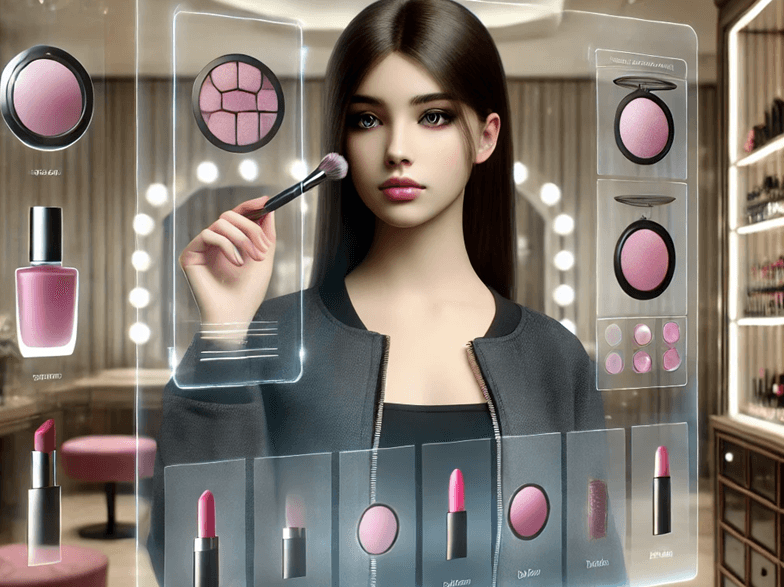Are you looking for a virtual makeup try-on experience and virtual makeover from the comfort of your home? Say hello to the future of VR makeup shopping – Makeup Virtual Try On apps.
The beauty industry is undergoing a digital revolution, with virtual makeup try-on tools at the forefront. These AI-powered applications allow users to experiment with different looks in real time, helping them find the perfect shade of lipstick, the ideal foundation match, or the most flattering eyeshadow—all without touching a single makeup brush.
This transformation is more than just a gimmick; it’s reshaping how consumers interact with cosmetics brands, bridging the gap between e-commerce and traditional retail. With major companies like Maybelline, L’Oréal Paris, and Ulta Beauty leading the charge, virtual makeover technology is becoming an essential part of the shopping experience.
The Rise of Virtual Beauty Technology
Augmented reality (AR) and artificial intelligence (AI) have made it possible for brands to offer highly personalized virtual try-on experiences. The idea is simple: users upload a selfie or enable their device’s camera, and the software overlays digital makeup in real-time.
Companies such as Maybelline’s Virtual Try-On Studio and Ulta Beauty’s GLAMlab use sophisticated algorithms to analyze facial features and skin tones, ensuring an accurate and natural-looking application. These tools allow users to test multiple makeup products in order to find the best makeup brands, reducing the guesswork involved in online beauty shopping.
How Virtual Try-On Works
Virtual makeup tools typically function through the following steps:
- Facial Mapping & AI Integration – The software scans key facial features, detecting skin tone, eye shape, lip contours, and overall symmetry.
- Real-Time Product Application – Digital versions of makeup products are applied instantly to simulate how they would look in real life.
- Customization & Experimentation – Users can tweak shades, textures, and finishes to find their ideal look.
- Direct Purchase Options – Many platforms integrate e-commerce features, allowing customers to buy products immediately after their virtual trial.
L’Oréal Paris’ Virtual Try-On tool, for example, enables consumers to test a full face of makeup digitally and then purchase the selected items directly from the website.
Why Virtual Makeovers Are a Game-Changer
1. Convenience & Hygiene
Traditional in-store testers have long been a staple in the beauty industry, but they come with hygiene concerns—especially in a post-pandemic world. Virtual try-on eliminates the need to swatch lipsticks or test foundations on the skin, making it a safer alternative.
2. Personalization & AI-Driven Recommendations
Advanced AI in virtual try-on tools can analyze skin undertones and suggest the most flattering shades. This level of personalization ensures users make more informed purchasing decisions, reducing product returns and dissatisfaction.
3. Seamless Online Shopping Experience
With the rapid growth of e-commerce, beauty brands need to offer a compelling digital shopping experience. Virtual makeup try-on tools provide customers with an interactive and engaging way to browse and buy products without stepping into a store.
The Top Virtual Makeup Try-On Platforms
Several brands have developed sophisticated virtual makeover tools, each offering unique features:
1. Maybelline Virtual Beauty Studio
Maybelline’s Virtual Try-On tool allows users to experiment with a wide range of makeup products, including foundations, lipsticks, and mascaras. It also features quizzes to help users find their perfect match.
2. Ulta Beauty’s GLAMlab
Ulta’s GLAMlab provides a high-quality virtual makeup experience, allowing users to test thousands of shades and products before purchasinh.
3. L’Oréal Paris Virtual Try-On
L’Oréal’s AI-driven tool not only enables virtual try-ons but also provides personalized recommendations based on skin type and undertones.
Challenges & Limitations
Despite the impressive capabilities of virtual try-on technology, there are some challenges:
- Device Limitations – The quality of virtual try-on experiences depends on camera resolution and lighting conditions.
- Color Accuracy – While AI does its best to match shades, screen variations and lighting can sometimes affect the perceived color.
- Consumer Trust – Some users remain skeptical about digital makeup, preferring in-person trials before making a purchase.
The Future of Virtual Beauty
With advancements in AI and AR, the future of virtual makeup looks promising. Brands are likely to integrate more sophisticated features, such as:
- Virtual skincare analysis to detect hydration levels, fine lines, and other skin concerns.
- Voice-activated beauty assistants to provide real-time makeup application tips.
- AI-powered product recommendations based on previous purchases and facial recognition technology.
As beauty brands continue to innovate, virtual makeup try-on tools will become an indispensable part of the beauty industry.
Final Thoughts
Virtual makeover technology is revolutionizing the way consumers engage with makeup products. Whether through Maybelline’s Virtual Try-On, Ulta’s GLAMlab, or L’Oréal’s AI-powered beauty tools, digital beauty is here to stay.
As more brands invest in virtual beauty, these technologies will become more sophisticated, bridging the gap between online and in-store shopping experiences. With the convenience, personalization, and innovation that virtual try-ons offer, the beauty industry is entering an exciting new era.

